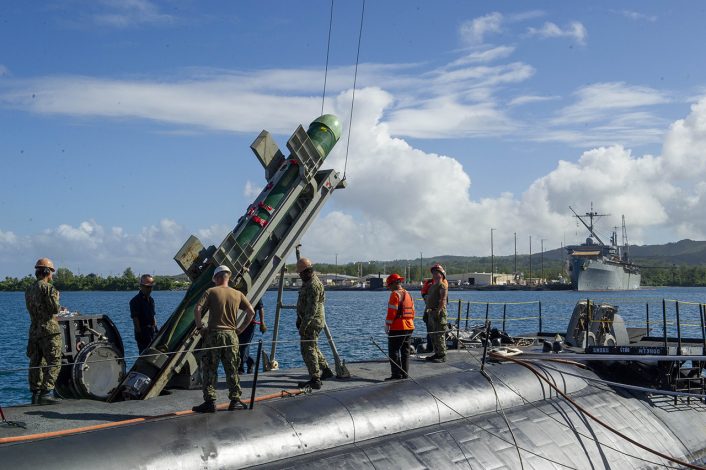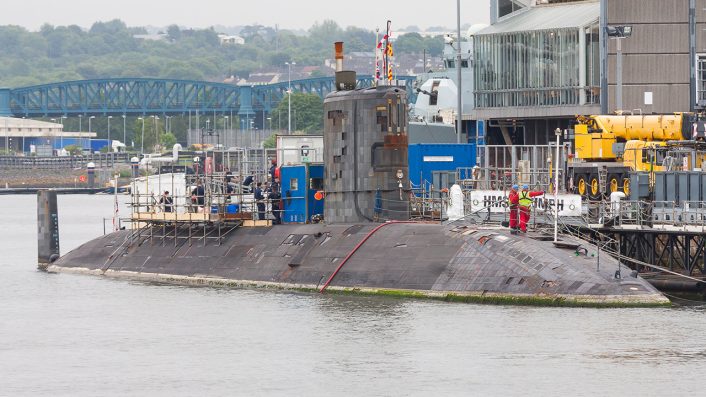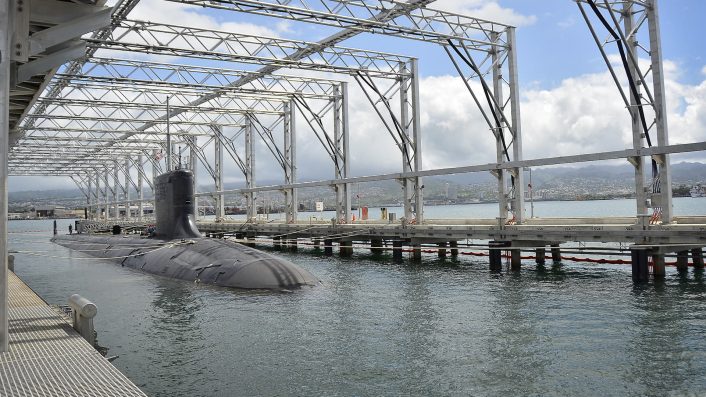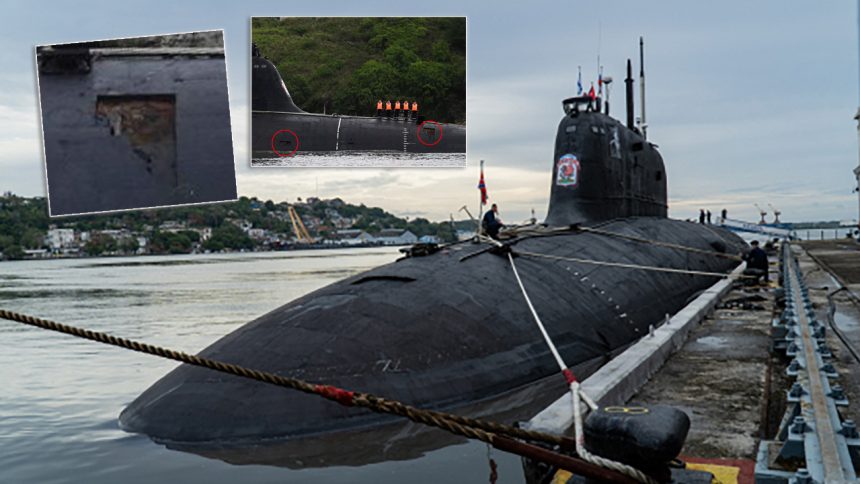The material state of Russia’s brand new Yasen-M class submarine has been called into question after apparent missing pieces were spotted on the hull as it arrived in Havana. But here’s why it’s a completely normal thing to see.
As previously reported by The Aviationist, a fleet of Russian Navy vessels arrived in the Cuban capital Havana on June 12, 2024 for an official port visit. These included the frigate Admiral Gorshkov, two support vessels, and the Yasen-M class submarine Kazan. The visit by this nuclear-powered cruise missile submarine (SSGN) drew the most attention from watchers online as well as international media, with Kazan being among the newest boats in Russia’s large sub-surface fleet.
Particular notice was paid to several images showing what appeared to be missing panels on the side of the submarine’s hull. This led to derision on social media of Russia’s technological capabilities, as well as articles calling the submarine’s state of repair into question. This came alongside reports in British media that a Royal Air Force P-8A Poseidon had detected and sighted the Russian submarine off Scotland on its transit to Cuba, leading to the UK Prime Minister being briefed on the situation.
The Russian submarine started falling apart during its trek to Cuba. Will it make it back to Russia?? 😂
I say declaring an emergency and heading to a port a few hours away in Florida to defect is the best course of action. https://t.co/JWdleDaXYW pic.twitter.com/8YqHu6nMsR
— Igor Sushko (@igorsushko) June 17, 2024
However, although there are several examples of Russian military’s basic issues of poor maintenance, this is probably not one of them.
In fact, while it is not possible to make any informed estimation with regards to the submarine’s current state of repair, these missing tiles are themselves of little concern.
Anechoic tiles
Known as anechoic tiles, many modern classes of submarine are coated almost all over the hull by thousands of these rubber-like patches.
Their purpose is twofold: first of all they dampen sounds coming from the inside of the submarine, protecting the boat from detection by passive sonar. Secondly, they are able to absorb some of the sound energy emitted by active sonar, reducing the overall sound signature that can be reflected back to anyone who might be listening.
The issue of them coming loose from the hull can be traced back to their very beginning, when they were trialled by the Kriegsmarine’s U-Boats early in the Second World War. After initial tests were burdened by the loss of tiles more development was put into an improved adhesive, but this was not available in large quantities before the war ended in 1945.
Unlike many other technologies where Germany had made significant advancements, anechoic tiles were not widely adopted by other nations immediately after the end of the war. The first post-war design to incorporate the feature operationally was the Soviet Victor class nuclear powered attack submarine. Western intelligence services codenamed the development ‘Cluster Guard’. Anechoic tiles, also known as acoustic tiles, then began appearing on Western submarines in the 1980s with the Royal Navy’s HMS Churchill and U.S. Navy’s USS Batfish, both nuclear-powered attack submarines (SSN).
Subsequent submarine classes often started to include anechoic tiles in their design, and the practice is now also being extended to some anti-submarine warfare (ASW) focused surface vessels like the Royal Navy’s future Type 26 City class frigate.

The issue encountered during the Second World War of tiles becoming dislodged during service is, however, one that persists to the present day. The reason for this is simple physics – as the submarine submerges deeper into the water the hull will become colder. As the hull coating will have been applied above surface the tiles are set according to the hull’s exact measurements at an above-water ambient temperature. When the metal hull contracts in the colder water, the tiles will be squeezed closer together. With repeated changes in temperature and multiple cycles of warming and cooling, and aided by the constant friction of moving through the water, eventually the cumulative wear and tear will cause the tiles to simply detach from the hull.
It is therefore common for submarines returning from long deployments to show large patches of missing tiles, ready for a patch-up when the boat goes into a post-deployment maintenance cycle in the same way that a surface vessel would require maintenance following a build-up of rust.

In recent years the durability of the anechoic coating on the U.S. Navy’s newest type of SSN, the Virginia class, has been a subject of media scrutiny. Termed officially as Special Hull Treatment, the U.S. Navy’s coating process involves gluing the tiles to a specially painted hull, before precisely filling in gaps between each tile with resin. This results in the very smooth, uniform appearance with the individual tiles only faintly visible. The Virginia class specifically uses a newer, more cost-effective application process, which has been alleged to be a contributing factor to the problem.
Virginia-class #submarine USS #HAWAII SSN776 returning to Pearl Harbor Thurs 6 June after a deployment to the western Pacific and Indian Oceans. She was just in the Bay of Bengal 3 weeks ago. She’s missing quite a few anechoic tiles – a good adhesive is just darned hard to find. pic.twitter.com/pyFhLTQ09Q
— Chris Cavas (@CavasShips) June 7, 2019
With details of the noise signature of submarines being some of the most sensitive information handled by modern military forces, it is difficult to speculate with any certainty how much or how little the missing tiles affect a submarine’s ability to stay undetected. However, it is likely that extensive testing has been conducted by those nations operating submarines with anechoic tiles to determine how differing amounts of tile loss impacts their boats’ operational capabilities. This could then inform how much degradation can be allowed in different operational situations before requiring rectification works.
Modern submarines are so quiet while operating that the development of non-acoustic methods of detecting submarines is a very active process. ASW aircraft often carry magnetic anomaly detectors (MAD) which are designed to detect the magnetic field of an underwater submarine.
P-8s tracking the Russian naval group are using tactical call signs to hamper identifying which squadron(s) they belong to.
This is more evidence to support the conclusion that the US Navy is monitoring/shadowing the Russian group just off the coast of Florida. https://t.co/HifBgEWL1Y
— TheIntelFrog (@TheIntelFrog) June 19, 2024
To combat this, submarines often pass through specialised degaussing, or magnetic silencing, facilities on a regular basis to reduce their magnetic fields as much as possible. This technique was developed during the Second World War for surface ships as a defence against naval mines that were activated upon detection of a large magnetic field.

Under the water, Russian and British submarines have been seen fitted with several types of devices believed to be designed for detecting the wake left in the water by other submarines. These devices likely measure for a number of different variables in the water, from temperature and water disturbances to latent radiation potentially left by the passing of a nuclear-powered submarine.
Submarine detection, tracking and engagement remains one of the most difficult aspects of warfare, and these missing tiles are unlikely to be changing that any time soon.









